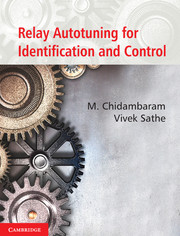Book contents
- Frontmatter
- Contents
- List of Figures
- List of Tables
- Acknowledgements
- Preface
- 1 Introduction
- 2 Improved Autotune Identification Methods
- 3 Cascade Controllers Tuning by Relay Autotune Method
- 4 Simultaneous Relay Autotuning of Cascade Controllers
- 5 A Simple Method of Tuning Cascade Controllers
- 6 Improved Saturation Relay Test for Systems with Large Dead Time
- 7 Identification of FOPTD Model using Single Symmetrical Relay Test
- 8 Autotuning of PID Controllers for Unstable FOPTD Systems
- 9 Autotuning of PID Controllers for Critically Damped SOPTD Systems
- 10 Estimation of SOPTD Transfer Function Model
- 11 Estimation of Five Parameters of Unstable SOPTD Model with a Zero
- 12 Identification of FOPTD Multivariable Systems
- 13 Identification of SOPTD Multivariable Systems
- 14 Tuning of Multivariable Controllers for Non-Minimum Phase Systems
- 15 Tuning of Multivariable Controllers by Genetic Algorithms
- 16 Summary and Conclusions
- Appendix A
- Appendix B
- Appendix C
- Nomenclature
- Problems
- Suggestive Reading
- References
- Index
15 - Tuning of Multivariable Controllers by Genetic Algorithms
Published online by Cambridge University Press: 05 June 2014
- Frontmatter
- Contents
- List of Figures
- List of Tables
- Acknowledgements
- Preface
- 1 Introduction
- 2 Improved Autotune Identification Methods
- 3 Cascade Controllers Tuning by Relay Autotune Method
- 4 Simultaneous Relay Autotuning of Cascade Controllers
- 5 A Simple Method of Tuning Cascade Controllers
- 6 Improved Saturation Relay Test for Systems with Large Dead Time
- 7 Identification of FOPTD Model using Single Symmetrical Relay Test
- 8 Autotuning of PID Controllers for Unstable FOPTD Systems
- 9 Autotuning of PID Controllers for Critically Damped SOPTD Systems
- 10 Estimation of SOPTD Transfer Function Model
- 11 Estimation of Five Parameters of Unstable SOPTD Model with a Zero
- 12 Identification of FOPTD Multivariable Systems
- 13 Identification of SOPTD Multivariable Systems
- 14 Tuning of Multivariable Controllers for Non-Minimum Phase Systems
- 15 Tuning of Multivariable Controllers by Genetic Algorithms
- 16 Summary and Conclusions
- Appendix A
- Appendix B
- Appendix C
- Nomenclature
- Problems
- Suggestive Reading
- References
- Index
Summary
Use of genetic algorithm for the tuning of decentralized and centralized controllers reported by Sadasivarao and Chidambaram (2003) is reviewed. The knowledge of the system is used to improve the search of genetic algorithms. All the loops are first tuned independently using the Ziegler–Nichols method or synthesis method. The detuning factors of 1.5 and 2 are used to get the range of the controller parameters. In this way, the unstable region (i.e., those settings that make the closed loop system unstable) is reduced from the region of search. The method is applied to a two input and two output distillation column model, given by Wood and Berry (1973). The knowledge-based genetic algorithm is converged faster than the method proposed by Vlachos et al. (1999).
Introduction
Many industrial control problems are of multi-input and multi-output (MIMO) in nature. The conventional multi-loop single-input and single-output (SISO) control systems are still used in industry because the formulation of MIMO control systems is not as straightforward. Centralized control scheme and decentralized control scheme are the two methods available for the control of such multivariable systems. In decentralized control system, single loop controllers are designed for each of the loops. Many methods are proposed for the design of decentralized controllers in the literature. Balachandran and Chidambaram (1996) compared BLT method, sequential design method and the method of inequalities for the design of decentralized controllers, and proved that the method of inequalities gave better performances than the other two methods.
- Type
- Chapter
- Information
- Relay Autotuning for Identification and Control , pp. 195 - 205Publisher: Cambridge University PressPrint publication year: 2014



